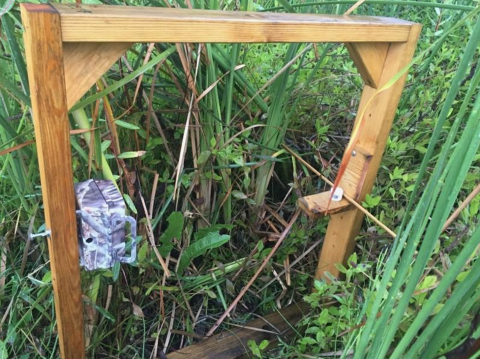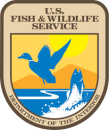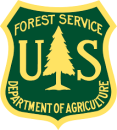Location
States
New MexicoEcosystem
River/streamIntroduction
Bosque del Apache National Wildlife Refuge is about 5 km south of San Antonio, New Mexico. The refuge contains the largest tract of public land within the active floodplain of the Rio Grande and hosts the only known population of the endangered New Mexico meadow jumping mouse (Zapus hudsonius luteus) within the Middle Rio Grande Valley in New Mexico. Beginning with a pilot year in 2016, jumping mice at the Refuge have been monitored during late May to late October using remote cameras to assess mouse abundance and habitat relationships.
Key Issues Addressed
River channelization and reduced flows have limited large-scale flooding events that maintained the riparian riparian
Definition of riparian habitat or riparian areas.
Learn more about riparian ecosystem in the Middle Rio Grande historically. Flooding helped create the specific vegetation conditions along the river that the jumping mouse requires. During the brief 3-4 month period they are not hibernating, jumping mice are believed to be limited by the availability of foraging habitat consisting of herbaceous wetland vegetation that is tall and dense. To better understand habitat preferences and spatial extent of jumping mice at the refuge, cameras were used as a less invasive method of tracking the population instead of the standard method of live trapping.
Project Goals
- Develop a standardized survey and monitoring method for jumping mice that is less invasive than live trapping
- Determine habitat conditions associated with more frequent jumping mouse detections
- Map spatial distribution of jumping mice habitat
Project Highlights
- Camera Traps: Cameras were used to monitor jumping mice from May to October in 2016 and 2017. Jumping mice hibernate outside of these months. Ten Reconyx PC850 cameras were deployed in 2016 for a total of 1,212 camera nights and 25 Reconyx PC850 cameras were deployed in 2017 for a total of 3,315 camera nights. Cameras were mounted in frames and aimed at a platform outfitted with climbing assistance structures. Bait tubes were initially used, but later removed due to competition and predation issues with other mammals.
- Site Selection: During the 2016 pilot year, sites were placed in best available habitat as assessed by refuge biologists. In 2017, sites were selected using stratified random sampling based on habitat quality. Habitat was assessed using a combination of Species Distribution Modeling, consultation with Refuge biologists, and site visits. Habitat was considered either high probability of occupancy (recent detections of jumping mice and/or high quality conditions) or low probability of occupancy (no recent detections of jumping mice and moderate or lower quality conditions). Random points within the high quality stratum were generated at twice the density of the low quality stratum. The best habitat with 10 m of each random location was assessed for camera placement.
- Habitat Attribute Sampling: Vegetation was measured during both set up and take down to better capture conditions for the duration the camera was active. A Lincoln soil probe was used to measure soil moisture in 4 quadrants around the camera frame, and the mean of these 4 measurements was recorded. Vegetation cover, height, and percent cover by plant species were sampled within a 1-m radius of the platform.
- Habitat-Relationship Analysis: Relationships between photo capture rates (jumping mice detections per 100 camera nights) and habitat data collected at each camera location were evaluated, with the proportion of days with a jumping mouse detected as the response variable. Explanatory variables included vegetation height, soil moisture, percent herbaceous cover, species diversity, and total percent cover of known forage plants.
Lessons Learned
- Cameras were an effective, minimally invasive way of detecting jumping mice relative to the conventional method of Sherman live traps. Sherman trapping rates in 2016 were only 0.08 jumping mice per 100 trap nights vs. 2.23 jumping mice per 100 camera nights.
- Over the two years of monitoring, 53 independent detections of jumping mice were recorded at 26 locations. No jumping mice were found in the southern section of the Refuge, which was formerly occupied. Soil moisture and vegetation composition in the southern section indicated that jumping mouse habitat was limited by ecological conditions.
- The current extent of estimated habitat at the Refuge (4-7 ha along 2 km of the Riverside canal) is well below the size recommended by the Species Status Assessment for the jumping mouse to ensure the continuation of the species at a location. This restricted habitat indicates that this population is vulnerable to extirpation.
- Photo capture rates peaked in late August through September (2.70 detections per 100 camera nights); photo capture rates were very low before mid-July (0.20 detections per 100 camera nights).
- Vegetation height was the best habitat predictor of jumping mice detections--photo capture rates (jumping mice detections per 100 camera nights) increased with vegetation height until a peak at about 2 meters.
- Recommendations for future monitoring include reducing camera monitoring to periods of high detectability (late July through early October), and placing cameras in areas with high vegetation cover to maximize detection.
- There was evidence of lower photo capture rates with increasing cover of knotgrass (Paspalum distichum). Anecdotal observations by Refuge staff suggest increasing knotgrass cover in recent years. Knotgrass is considered a native species by the USDA and has some value as wildlife forage. However, it can form homogenous mats and outcompete other wetland species.
- In the pilot year, two different camera types were deployed in pairs (Reconyx PC800 and PC850). No jumping mice were detected on the infrared PC800s, likely due to grainier imagery and lack of color in the photos, so only the data from the Reconyx PC850s were used for analyses.
- In the second year of the study, cameras were programmed not to take photos after 9AM or before 6PM as jumping mice are nocturnal and no photos of jumping mice taken during 2016 were taken before 8PM or after 7 AM. Eliminating photos during this period minimized processing of ghost photos (photos with no animals, often triggered by blowing vegetation during windy afternoons).
- Camera platforms could be modified to adjust more easily in order to maximize detection rates. Although the platforms were made to be adjustable so they could be set at the appropriate height for a given location, in practice, the wooden frames would swell to such a degree that they could not be adjusted. This could be mitigated by drilling larger holes in the frames such that platform and camera can be easily adjusted in the field.
Next Steps
Restoration Success Monitoring: Refuge staff are planning restoration activities to expand jumping mouse habitat at the Refuge. Restored habitat will be monitored for colonization using camera trapping techniques informed by this study.
- Continue monitoring habitat conditions and jumping mouse distribution
- Continue restoration activities to expand/enhance jumping mouse habitat
- Further examine the relationship between jumping mouse detections and plant community composition to inform management actions
Funding Partner
Resources
- Bosque del Apache National Wildlife Refuge Website
- New Mexico Meadow Jumping Mouse Background Information
- Rovero, Francesco, and Fridolin Zimmermann, eds. (2016). “Camera trapping for wildlife research.” Pelagic Publishing Ltd.
- Camera Trapping Information Exchange
Contacts
- Sarah Lehnen, Biometrician, US Fish and Wildlife Service, sarah_lehnen@fws.gov
- Jeff Sanchez, Supervisory Biologist, Bosque del Apache NWR, jeff_sanchez@fws.gov
- Megan Goyette, Refuge Biologist, Bosque del Apache NWR, megan_goyette@fws.gov
- Dr. Jennifer Frey, Department of Fish, Wildlife and Conservation Ecology, New Mexico State University, jfrey@nmsu.edu
- Greg D. Wright, Wildlife Biologist, US Forest Service, gregorywright@fs.fed.us
Case Study Lead Author
- Ashlee Simpson, CART Graduate Research Assistant, University of Arizona
Suggested Citation
Simpson, A. C. (2018). “Camera-Based Monitoring of the New Mexico Meadow Jumping Mouse at Bosque del Apache National Wildlife Refuge.” CART. Retrieved from https://www.fws.gov/project/camera-based-monitoring-new-mexico-meadow-jumping-mouse.








